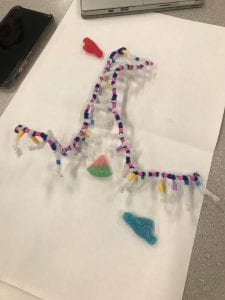DNA
1) explain the structure of DNA- use the terms nucleotides, antiparallel strands, and complimentary base pairing
– DNA is a large polymer that is constructed of nucleotide monomers. DNA, also known as deoxyribonucleic acid, consists of two backbones that are made of repeating sugar-phosphate units and DNA is twisted into a helix shape. Contains 4 types of nucleotides, each built from a phosphate, a nitrogen base, and a pentose sugar (deoxyribose). There are 2 purines called adenine and guanine and 2 pyrimidines called cytosine and thymine, these nucleotides bond in several varying ways. Backbones of DNA are antiparallel which means that one strand goes from 3′-5′ and the other strand goes 5′-3′. 3’= side with the hydroxyl and 5’= side with the phosphate. If a strand starts with 3′ it is the leading strand and if a strand starts with 5′ it is the lagging strand. Bases will only bond in certain ways. For example, Adenine will only bond with Thymine and cytosine will only bond with Guanine. Complimentary base pairing is when nucleotides are always present in the nucleus and they move into place and form h- bonds with partner on the strand. This is Facilitated by DNA polymerase.
2) How does this activity help model the structure of DNA? What changes could we make to improve the accuracy of this model? Be detailed and constructive
-Making the pipe cleaner model helped with our understanding and learning of the structure of DNA. You could see the antiparallel strands, sugar phosphates backbones, and the different bases and the h-bonds forming bases. By creating our own model we practiced the concept of the structure of DNA. A way in which the activity would be able to be improved is by finding an alternate source to the white pipe cleaner hooks, our team found difficulty in attaching the hooks to both each other and the strand without breaking or detaching. With an alternate, such as plastic hooks or something alike, it would make the process much easier and make the backbones able to twist better to represent the double helix. The 3′ and 5′ ends of the backbones were hard to indicate and cold be more clear to do so.
Replication
1) When does DNA replication occur?
– occurs prior to cell division, occurs in three stages- Unwinding, Complimentary base pairing, and joining
2) Name and describe the 3 steps involved in DNA replication. Why does the process occur differently on the “leading” and “lagging” strands?
-1. Unwinding and unzipping (is the process of the DNA strands separating from one another forming a template for another strand, double helix shape holds, complimentary backbone)
-2. Complimentary base pairing (nucleotides are always present in nucleus, Nucleotides move into place and form H-bonds with partner on strand, Facilitated by DNA)
-3. Joining of adjacent nucleotides (Nucleotides on new strand from covalent bonds, the strands must be built from 5’ to 3’ which means they must be read from 3’ to 5’ because they are antiparallel)
– The process occurs differently because the leading strand continues as DNA unzips when the lagging strand fragments form as DNA unzips.
– The enzyme, DNA ligase glues these fragmented strands together
Two Identical molecules are created
3) The model today wasn’t a great fit for the process we were exploring. What did you do to the model the complimentary base pairing and joining of adjacent nucleotides steps of DNA replication. In what ways was this activity well suited to showing this process? In what ways was it inaccurate? – unable to demonstrate the unwinding and unzipping process
– Unable to demonstrate unwinding and unzipping process
-this lab gives us representation on how DNA is replicated and how enzymes move. A problem is we couldn’t see how the “leading” and “lagging” strands were acting differently as we moved the candies out and attached the two strands together.
-unable to really show the ligase. The enzyme passed and then everything became attached. couldn’t see fix errors or bring the sugar-phosphate







Leave a Reply